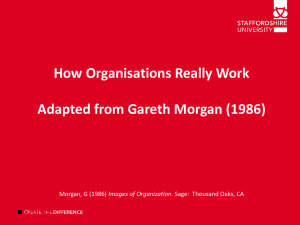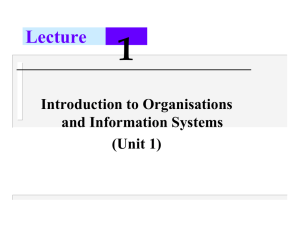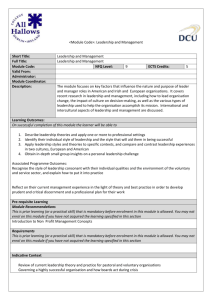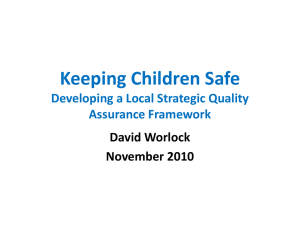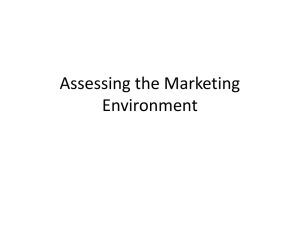Human Capital in Organisations
advertisement
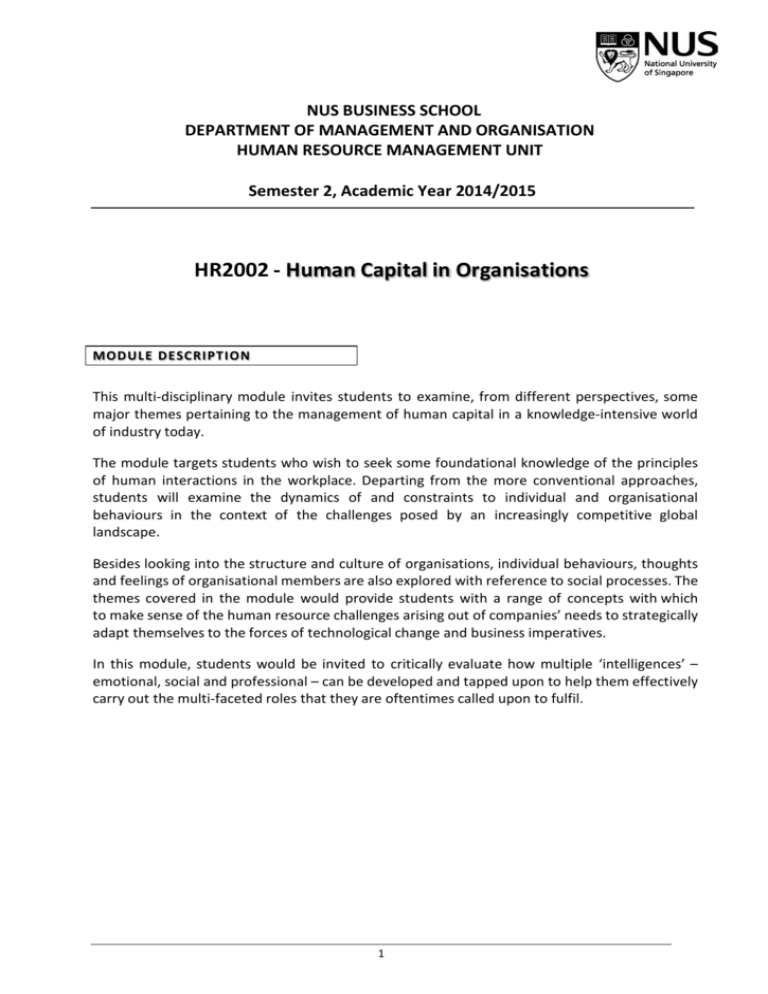
NUS BUSINESS SCHOOL DEPARTMENT OF MANAGEMENT AND ORGANISATION HUMAN RESOURCE MANAGEMENT UNIT Semester 2, Academic Year 2014/2015 HR2002 - Human Capital in Organisations MODULE DESCRI PT I ON This multi-disciplinary module invites students to examine, from different perspectives, some major themes pertaining to the management of human capital in a knowledge-intensive world of industry today. The module targets students who wish to seek some foundational knowledge of the principles of human interactions in the workplace. Departing from the more conventional approaches, students will examine the dynamics of and constraints to individual and organisational behaviours in the context of the challenges posed by an increasingly competitive global landscape. Besides looking into the structure and culture of organisations, individual behaviours, thoughts and feelings of organisational members are also explored with reference to social processes. The themes covered in the module would provide students with a range of concepts with which to make sense of the human resource challenges arising out of companies’ needs to strategically adapt themselves to the forces of technological change and business imperatives. In this module, students would be invited to critically evaluate how multiple ‘intelligences’ – emotional, social and professional – can be developed and tapped upon to help them effectively carry out the multi-faceted roles that they are oftentimes called upon to fulfil. 1 OBJECTIVES This module seeks to re-orientate students’ perceptions and thinking in an era of new business paradigms. Thus, the module is designed to: • examine how individuals may respond to global forces that impact technology, organisations and people; • provide a framework for understanding the structure and culture of organisations and how the interactions of the different components may influence an individual’s performance in organisations; • enhance one’s understanding and appreciation of working with diverse individuals, • develop an understanding of and insights into the importance of one’s leadership and team roles in negotiating through the web of organisational life; and • rethink one’s mental models, performances and contributions in the organisations of today. MODULE OUTLINE 1. Globalization and Its Effects on the Workplace In the globalized workplace, everyone must respond to a rapidly changing society and constantly shifting demands and opportunities. Information and technological change are modifying organisations and bringing added emphasis on knowledge and knowledge workers. Because knowledge constantly makes itself obsolete, the pressure is on individuals to adopt a learning ethic and continually apply new knowledge to problems and opportunities. • • 2. Globalization, technology and customization Changing paradigms of management Organisation Structure, Culture and Strategy This segment will examine how organisations strategically respond to the demands of the globalised environment by aligning their structure, culture and strategy. In this connection, students will look at various ways by which organisations structure their processes to create value. The critical role of culture in the success of an organisation is also examined by exploring how varied relationships are involved in the implementation of organisational strategies. References and illustrations to these concepts will be made by looking at how successful organisations are structured in the context of the contemporary environment. • • • Organisation Structure Organisation Culture The link between organisation structure, culture and strategy 2 3. People and Processes in Organisations An important part of organisational life involves working with and through people. In the context of changing business paradigms, the ability to negotiate through the web of organisational hierarchies and complexities becomes paramount to one’s success at work. Hence, this segment emphasizes on people and their behavioural and emotional interactions with one another at the workplace. It would explore the range of social and emotional competencies required by individuals to perform and contribute effectively in one’s roles as a leader and team member. Central to the discussion of the segment would be emphases on theories and concepts that would enable students to find new perspectives and approaches in managing relationships in organisations. In addition, the intricacies of managing the politics of interactions would be investigated through exploring the dynamics of peer-to-peer; superior-to-subordinate and customer-to-supplier interactions. Without a doubt, an amalgamation of the know-how to manage one’s emotion, an ability to negotiate role-identities and the awareness to recognize the significance of one’s roles in an organisation, would be a catalyst to creating synergy at work and achieving a satisfactory level of work performance. • • • 4. Organisational Roles: Leadership and Team Roles Diversity in Interactions: Diversity Challenges & Reframing Diversity Workplace Interactions: Interpersonal Dynamics The Self in Organisations This segment examines the multifaceted tasks and challenges encountered by individuals in an organisational setting. As organisations strive to become more competitive in the global business environment, individuals are expected to manage new forms of pressures and relationships. Hence, the ability to make sense of and develop one’s capabilities is of utmost importance to perform effectively in the highly competitive work place of today. Change is inevitable, and the premium is on the adaptability of the individual to make the transitions through changes more effectively and easily. In the light of these unprecedented demands on students whose entry to the workplace is imminent, this segment of the module will focus on the individual’s role in managing change, the imperative to learn and manage knowledge; and his/her strategic plan and choices in managing his/her career development. The need to develop multiple competencies as well as reframe one’s mental models to remain relevant is also expounded on to encourage students to think and consider beyond his/her current role identities. • • • Managing Change and Learning Exploring Career: Development and Professionalism Understanding Competencies and Reframing Mental Models 3 TEACHING METHODOLOGY The teaching format of this module is via lectures and tutorials. The lectures cover the key concepts and their applications through organizational examples. The tutorials are designed to be flexible, interactive and supportive of active and creative learning. Students are urged to make the best use of this mode of teaching, to cultivate an active learning mindset, and to be involved and participative. ASSESSMENTS Students will be assessed on the basis of both individual and group work. Continuous assessments account for 50% of the final grade, while the final open-book examination makes up the other 50%. I. Continuous Assessments (50%) There will be 2 continuous assessments as follows: CA1 CA2 Learning Contribution Group Project 15% 35% Details of the continuous assessments are as follows: CA1 Learning Contribution (15%) For learning contribution, marks will be awarded based on active and quality contributions to class discussion as well as for demonstrating good learning attitudes. CA2 Group Project (35%) This is a group assessment. The size of each group depends on the class size. Please check with your tutor for more details on groupings for the project. This project comprises two parts: Part 1 (15%) Presentation Each group will be assigned a project topic by your tutor. Starting from Session 6, each week there will be one group presentation. Your tutor will do the scheduling. The group will make a 20-minute presentation followed by a 10-minute Q&A. All group members must be present on the day of presentation. The presentation will be assessed on the following: 4 a. b. c. d. Relevance and quality of information presented; Depth of critical analyses and discussion; Adding value to audience learning and understanding of the topic; Effectiveness of the delivery Part 2 (20%) Besides the in-class presentation, the group will continue to work on the assigned topic and submit a written report at the end of the semester. The report will be assessed on the following: a. introduce new perspectives and insights pertaining to the topic; b. apply and evaluate your experiences, personal and/or organisational, in the context of the topic; and c. synthesize information collected, either through primary or secondary research, adding value to the discussion of the topic. As a guide, the methodologies that could be used for the group project may include field studies, company visits, interviews, surveys, focus group discussions and content analyses, including company practices and developments relevant to the engineering profession, etc. Mere regurgitation of lecture materials or reproduction from reference sources is not encouraged. Students should seek to add value via new insights, critical opinions, and applications of concepts learned The written report which should not exceed 3000 words, excluding references, is to be submitted latest by session 13 in class. Submissions that are later than the deadline may not be granted credits. References for Library Research The following journals and periodicals provide a wealth of information which students could use in their further reading and research: Academy of Management Journal, Academy of Management Review, Administrative Science Quarterly, Human Relations, Harvard Business Review, Journal of Applied Psychology, Journal of Organisational Behavior, etc. II. Final Exam (50%) This is an open-book examination. Students are individually required to answer 2 out of 3 questions (25% each). The total time allotted for the exam is 1½ hours. 5
